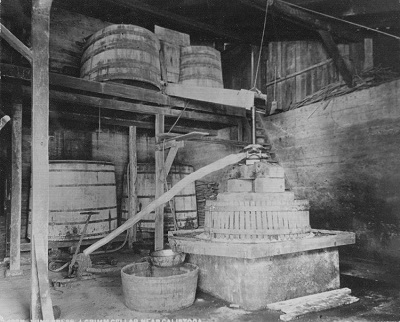Calistoga, Wine and Viticulture
Winemaking in Calistoga, pt. 1
 Sam Brannan was one of the first people in the Calistoga area to commercially produce wine. By 1862 he had several thousand acres of land on which he planted nearly 20,000 French vine cuttings. Within five years he was producing 23,000 gallons of wine and brandy. His winery went under, as did his resort and all other financial holdings, when his wife, Anna Eliza Corwin, divorced him in 1872.[1]
Sam Brannan was one of the first people in the Calistoga area to commercially produce wine. By 1862 he had several thousand acres of land on which he planted nearly 20,000 French vine cuttings. Within five years he was producing 23,000 gallons of wine and brandy. His winery went under, as did his resort and all other financial holdings, when his wife, Anna Eliza Corwin, divorced him in 1872.[1]
The oldest large-scale winery in Calistoga was the Kortum Wine Cellar off Kortum Canyon Road. Built in 1875 by German immigrant Louis Kortum, it was so popular a local newspaper in 1884 exclaimed: “From morning until night, wagons loaded with grapes stand waiting in line…and so fast as one load is disposed of, another is drawn onto the scales.”[2]
Fellow German immigrant and barber Jacob Schram founded Schramsberg Vineyards in 1862. He hired Chinese laborers to dig the underground tunnels where they would soon store nearly 30,000 gallons of wine.[3] During the 1880s he shipped his award-winning Riesling, Burgundy, Chasselas, and Hock to locales as far away as New York. His success was sealed when Robert Louis Stevenson visited Schramsberg on his honeymoon. Stevenson’s interest in California wine and his enjoyable visits to the Napa Valley wineries led him to write the now famous line “and the wine is bottled poetry.”
Chateau Montelena was established by New Hampshire native and San Francisco entrepreneur Alfred L. Tubbs in 1882 on his newly purchased land at the base of Mount Saint Helena. He hired famous winery designer engineer Hamden McIntyre to lay out the structure, then brought in French architects to add the castle-like features. Tubbs not only had his own vineyards and winery, but was also the largest producer and acreage owner in the area. His first winery, Hillcrest Winery, was built of wood in 1882, but it eventually burned down. Chateau Montelena, built of stone, replaced it in 1888. Within eight years his winery had become the seventh largest in the valley. A few years prior to his death in 1896, Tubbs was producing 350,000 gallons of Cabernet Franc, Chasselas, Malbec, Merlot, and Sauvignon Blanc.
In 1880 there were only about 3,500 acres in Napa County planted in grapevines; that figure increased by nearly 500% by the next decade. By 1890, 1,513 acres of Calistoga real estate were planted in vinyards that produced 5,037 tons of grapes annually. Zinfandel was the most commonly grown variety, with Riesling and Burger close behind.[4] Most vineyard owners sold their grapes and did not produce wine.
Phylloxera, an insect that feeds on the roots of grapevines, devastated vineyards in the United States and Europe in the late 19th century. The pest may have begun its attack as early as the 1860s in Sonoma and Yolo counties. By the 1870s, phylloxera had crossed the border – possibly through the Carneros region, which is spread across both Napa and Sonoma counties – and was attacking many of the vineyards in the valley. Curiously enough, while most vineyards in the rest of the county suffered, Calistoga remained relatively unaffected as late as the early 1890s. Some vineyard owners in Calistoga planted resistant rootstock as a precaution. Riparia was the preferred resistant, however Zinfandel and Lenoir were also used. The biggest crop killer in 1892 was not the “phylloxera plague” but bad weather. C.M. Burgess, chairman of the County Board of Supervisors and owner of a 35-acre vineyard near what is now Larkmead Lane, lamented that his 1892 crop, while mostly spared from phylloxera, was only a third of its usual size because of several severe frosts in the spring followed by a cool summer.
The first time millions of gallons of wine were lost in California was during the 1906 Earthquake. About half of the wines stored in the state were destroyed by the fires that ravaged what was left of the city that had not collapsed during the quake. On the 20th anniversary of the earthquake, the California Grape Grower commented, perhaps hyperbolically, “A cluster of homes on Telegraph Hill were saved by desperate Italians who poured their stores of wine on their burning roofs when the city’s water supply was cut off by the destructive upheaval.”[5] California wineries that had survived phylloxera saw much of their hard work vanish, which put a serious financial strain on many vintners. However, the Napa County wineries that had not lost their stock stored in San Francisco saw their prices more than double, from 11 and 12 cents a gallon for wholesale dry wine up to 28 cents (Sosnowski, 2009). But the biggest disaster was yet to come: Prohibition.
[1] Sullivan, C.L. (1994). Napa Wine. San Francisco: Wine Appreciation Guild, Ltd.
[2] Haynes, I. (1980). Ghost Wineries of Napa Valley. San Francisco: Wine Appreciation Guild, Ltd.
[3] Sullivan.
[4] Board of State Viticultural Commissioners of California. (1891). Grape Growers, Wine Makers and Distillers of California. Sacramento: State Office.
[5] Sosnowski, V. (2009). When the Rivers Ran Red. New York: Palgrave Macmillan.


